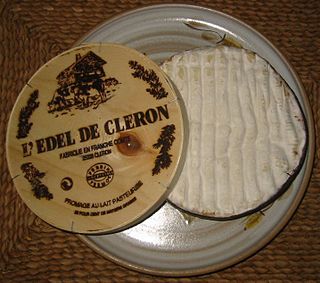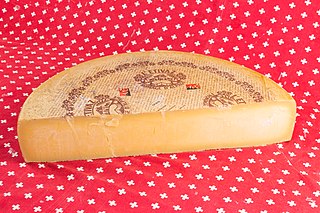
Gruyère is a hard Swiss cheese that originated in the cantons of Fribourg, Vaud, Neuchâtel, Jura, and Berne in Switzerland. It is named after the town of Gruyères in Fribourg. In 2001, Gruyère gained the appellation d'origine contrôlée (AOC), which became the appellation d'origine protégée (AOP) as of 2013.

Raclette is a Swiss dish, also popular in the other Alpine countries, based on heating cheese and scraping off the melted part, then typically served with boiled potatoes. Raclette cheese is historically a dish originating from the canton of Valais in Switzerland. This cheese from Valais benefits from an AOP. Raclette cheese is also a Swiss-type cheese marketed specifically to be used for this dish.

Swiss cuisine is an ensemble of national, regional and local dishes, consisting of the ingredients, recipes and cooking techniques developed in Switzerland or assimilated from other cultures, particularly neighboring countries. The diversity and comprehensiveness of Swiss gastronomy reflects the linguistic, cultural and geographical diversity. The climate of Switzerland allows for a large variety of terroirs, and therefore a wide range of indigenous food, from simple cereals to refined products like cheese and wine.

Beaufort is a firm, raw cow's milk cheese associated with the gruyère family. An Alpine cheese, it is produced in Beaufortain, Tarentaise valley and Maurienne, which are located in the Savoie region of the French Alps.

Banon is a French cheese made in the region around the town of Banon in Provence, south-east France.

Pont-l'Évêque is a French cheese, originally manufactured in the area around the commune of Pont-l'Évêque, between Deauville and Lisieux in the Calvados département of Normandy. It is probably the oldest Norman cheese still in production.

Saint-Nectaire is a French cheese made in the Auvergne region of central France.

Cabécou is a soft goat cheese that comes from the Midi-Pyrénées region of southern France. It has a thin striped rind and after two weeks its crust grows blue mold changing its taste. It is one of Aquitaine's most famous foods. Aquitaine is a region in the lower bottom of France. The coloration of this creation is a calm cream color. Cabécou is a cheese generally made from raw goat's milk originating from the regions of the Massif Central such as Quercy, Rouergue, Haute-Auvergne, Limousin and Périgord.

Époisses, also known as Époisses de Bourgogne, is a legally demarcated cheese made in the village of Époisses and its environs, in the département of Côte-d'Or, about halfway between Dijon and Auxerre, in the former duchy of Burgundy, France, from agricultural processes and resources traditionally found in that region.

Bleu des Causses is a French blue cheese made from whole cow's milk. Some consider it as a mild variant of Roquefort. The cheese has a fat content of 45% and is aged for 3–6 months in Gorges du Tarn's natural limestone caves. The ripening process involving naturally temperature-controlled cellars is the major element that gives it its special aroma. Today, it is a relatively rare cheese that is only made by a handful of small producers.

Chabichou is a traditional semi-soft, unpasteurized, natural-rind French goat cheese with a firm and creamy texture. Chabichou is formed in a cylindrical shape which is called a "bonde", per the shape of the bunghole of a wine barrel. and is aged for 10 to 20 days. It is the only goat cheese that is soft ripened allowed by Protected Designation of Origin regulations to be produced using pasteurized milk. Chabichou is very white and smooth, and flexible to the palate, with a fine caprine odor.

Bleu de Gex is a creamy, semi-soft blue cheese made from unpasteurized milk in the Jura region of France.

Tête de Moine AOP is a semi-hard cheese manufactured in Switzerland. It is classified as a Swiss-type or Alpine cheese, and was invented and initially produced more than eight centuries ago by the canons of the abbey of Bellelay, located in the community of Saicourt, district of Moutier, in the mountainous zone of the Bernese Jura, the French-speaking area of the Canton of Bern as well as the Canton of Jura.

Vacherin Fribourgeois a Swiss semi-hard cheese made from thermised milk. It is produced under Swiss AOC in the canton of Fribourg, where Gruyère also originates. It has a slightly acidic, resiny flavor, akin to Italian Fontina, with a varying strength depending on the age and type. It is also a basic component lending character to fondues. Vacherin Fribourgeois has Swiss AOC status with 6 varieties being available:

Fourme de Montbrison is a cow's-milk cheese made in the regions of Rhône-Alpes and Auvergne in southern France. It derives its name from the town of Montbrison in the Loire department.

Édel de Cléron is a traditional French cheese of relatively recent origin which carries the name of the village where it is made, Cléron, in the valley of the Loue of the Doubs department in Franche-Comté.

In Switzerland, the appellation d'origine protégée is a geographical indication protecting the origin and the quality of traditional food products other than wines.

Switzerland has a strong and ancestral dairy farming and cheesemaking tradition. The breeding of cattle, sheep and goats for milk is attested in the Neolithic period and, since Antiquity, cheese has been exported from the Alpine regions. The rugged nature of the country makes approximately 80% of the agricultural land unsuitable for cultivation, which is therefore mainly exploited for cattle and sheep farming. This mode of exploitation has forged a large part of the Swiss landscape, in the Alps, the Jura and on the Swiss Plateau.



















